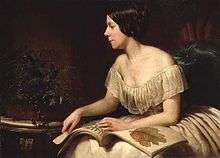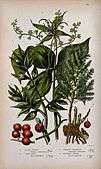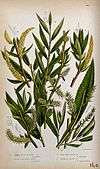Anne Pratt


Anne Pratt (5 December 1806 – 1893) was a botanical and ornithological illustrator and author from Strood, Kent. The second of three daughters of Robert Pratt (1777–1819), a grocer, and Sara Bundock (1780–1845), Pratt was one of the best known English botanical illustrators of the Victorian age.[1] Owing to poor health and a 'stiff knee' in childhood, she missed out on 'outdoor activities' and was encouraged to occupy herself by drawing. Anne Pratt was educated at Eastgate House, Rochester, and introduced to botany by Dr. Dods, a family friend.[1] She moved to Brixton, London, in 1826, where she developed her career as an illustrator. She settled in Dover in 1849, then in East Grinstead in 1866, where she married John Pearless; they then moved to Redhill. Anne Pratt died in Shepherd's Bush, London.
Anne Pratt wrote more than 20 books, which she illustrated with chromolithographs on which she collaborated with William Dickes, an engraver skilled in the chromolithograph process. Her works were written in popular style but were said to be accurate, and are partly responsible for the popularising of botany in her day. From her first book, Flowers and Their Associations, her work sold well, but she never achieved critical acclaim, owing to prejudice against her on the grounds that she was self-taught.[2] Her masterpiece is probably The Flowering Plants, Grasses, Sedges, and Ferns of Great Britain and Their Allies the Club Mosses, Pepperworts, and Horsetails, a six-volume project covering more than 1500 species, with 300 illustrations, that took over a decade to publish in full (1855–1873). This work had a remarkably long life as a standard reference work: the illustrations of ferns in the final volume continued to be used into the second half of the twentieth century, appearing, unattributed and in very much reduced in size and in half tone, in the Observer's Book of [British] Ferns [3]
Selected works
- The Field, the Garden, and the Woodland, 1838.
- Flowers and their associations, 1840.
- The Pictorial Catechism of Botany. London: Suttaby and Co., 1842.
- The Ferns of Great Britain, c. 1850.
- Wild Flowers, 1852 (2 vols.). Also published as classroom wall hangings.
- Poisonous, Noxious, and Suspected Plants, of our Fields and Woods, 1857.
- The Flowering Plants, Grasses, Sedges, and Ferns of Great Britain and Their Allies the Club Mosses, Pepperworts, and Horsetails. London: Frederick Warne and Co., 1855–1873, 6 vols. (Originally only 5 volumes, published 1855–1866, as 'The Flowering Plants of Great Britain; the 6th volume, on grasses, sedges, and ferns, was added in 1873).
- Chapters on Common Things of the Sea-side. Society for the Promotion of Christian Knowledge, 1850.
- Our Native Songsters. Society for the Promotion of Christian Knowledge, 1853.
- Haunts of the Wild Flowers. Routledge, Warne and Routledge, 1863.
- The Garden Flowers of the Year. Religious Tract Society, 1846.
- Wild Flowers of The Year. Religious Tract Society, 1846.
- The Excellent Woman as Described in Proverbs 31. Religious Tract Society, 1863.


| Wikimedia Commons has media related to Anne Pratt. |
References
- 1 2 Kramer, Jack 1996. Women of Flowers: A Tribute to Victorian Women Illustrators. New York, Stewart, Tabori & Chang, 1996.
- ↑ "The Art of Botanical Illustration: Women Illustrators". University of Delaware Library website.
- ↑ The Observer's Book of Ferns compiled by W.J. Stockoe, published by Frederick Warne, no date; The Observer's Book of British Ferns compiled by W.J. Stockoe, published by Frederick Warne, 1950.
- ↑ IPNI. Pratt.